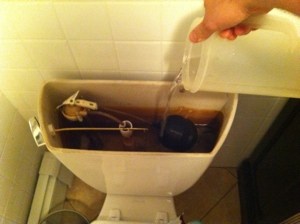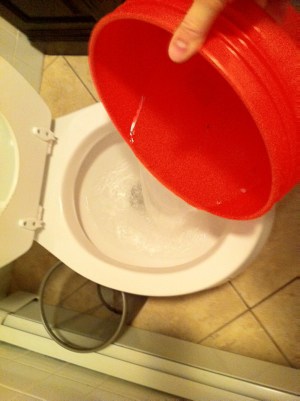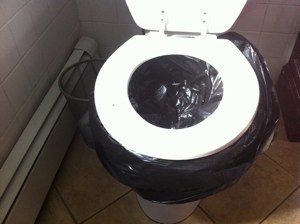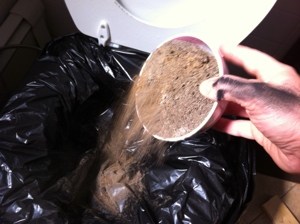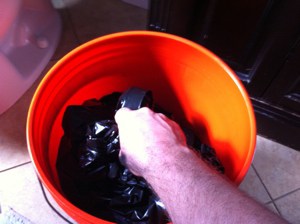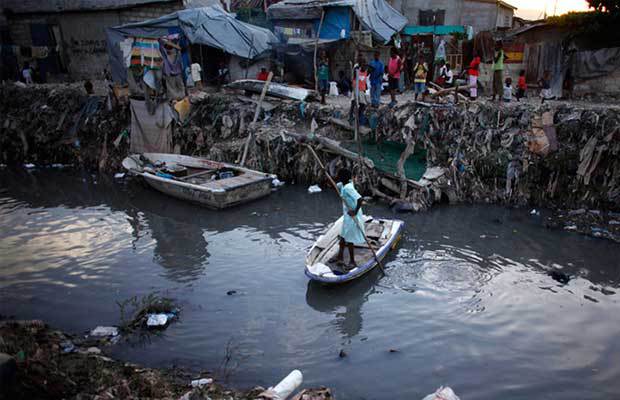
In a SHTF situation, proper sanitation is of utmost importance if you want to keep your family from getting seriously sick. When you add to that a lack of medical facilities due to grid-down issues, staying healthy becomes even more crucial.
- Survival Sanitation: It all Begins with the Hands
- Survival Sanitation: Disposing of Human Waste
- Survival Sanitation: Disposing of Garbage Off-Grid
When the grid goes down it doesn’t take long for serious sanitation problems to erupt. Take Auckland New Zealand for example:
In 1998, Auckland suffered a 5-week long power outage that halted water supplies, causing a large part of the city’s apartment dwellers and office workers to lose the ability to flush. Since the average person did not know how to properly deal with human waste, after only three days the resulting lack of waste-water services quickly escalated into a sanitation nightmare.
Here are two accounts of that time (please see footnotes for full articles):
Since water and sewage rely on electrically-driven pumps to get them into office blocks and towers, these services often aren’t available either. What little power is available is being used by emergency and civil services as far as possible, with other services like traffic lights being run if there’s anything to spare. Many office blocks have no power, water, or sewage services available. Combine the lack of sanitation with absence of air conditioning and you can imagine what conditions are like in parts of these buildings.
And here is an account from someone who was tasked in writing up a white paper for the New Zealand government on the effects caused by no running water:
People in general are not smart. Rather than try and conserve or make a plan once the water stopped flowing, they would flush their toilets. Without power from the force of water pressure the tank doesn’t refill. The domino effect is not only gross but staggering, what human beings that have never lived beyond modern conveniences will do is unimaginable.
What I researched and wrote about blew my own mind…when people were actually confronted with such a situation, they went where ever they could – they filled the toilet, the toilet tank, the tub, the shower, the sink – when the bathrooms became uninhabitable, they went in corners, boxes, bags, closets…most however left by the time they were using the tub. Guess how long that took? That’s right, three days!.[2]
How to Dispose of Human Waste in a Grid-Down Situation
If you’re in a situation where the grid goes down and the water stops flowing, you’ll want to be sure you’re correctly dealing with human waste.
Here’s how:
If You Have a Septic System
First off, if you have your own septic system, you’re in a better spot over others connected to a town/city sewer line. With a septic system, as long as you have availability to water (from storage or any grey water source), you’ll still be able to flush.
How to Flush without Running Water
If you are on Town/City Sewer LinesIf you’re short on water, then I recommend you follow the same procedures as those who are connected to town/city sewer lines:
If you’re connected to a town or city sewer line then the the absolute first step is:
If the sewer main is down, don’t flush the toilet. Not flushing will prevent your lines from mixing with neighborhood crap and backing up into your plumbing (not just the toilets but the sink and tub too).
If you’re absolutely sure there is no issue with the sewer lines, then you can follow the same method as someone on a septic system. Just be sure you have enough water for drinking, cleaning and cooking.
Non-Water Dependant Methods of Waste Disposal
Before I get into some of the non-water dependent methods of waste removal, there are three things you need to be mindful of: flies, pests and pets.

Flies especially are notorious for landing on your food and plates while eating, and wouldn’t think twice about doing that after having just enjoyed a fecal feast at your expense. And what will soon follow is a fecal-borne pathogen’s ultimate fantasy — amounting to a health nightmare for you and your loved ones.
Given that, you want to do everything in your power to prevent them from coming into contact with your excrement by keeping it covered and clean (more details to follow).
Waste Disposal in a Rural Area
If you live in the boonies or a semi-rural area but are still connected to the grid, consider yourself lucky. For you guys, it’s just a matter of doing your business outside.
The Cat Hole
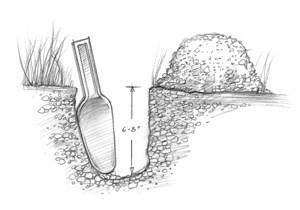 In a short-term emergency, a few cat holes is all you need. Just take a garden trowel, a small shovel, or a post digger and make a hole about 6-8 inches deep and 4-6 inches in diameter. Do your business in the hole, wipe, throw the toilet paper (or leaves 🙂 ) in there too, and cover it up with the dirt you took out.
In a short-term emergency, a few cat holes is all you need. Just take a garden trowel, a small shovel, or a post digger and make a hole about 6-8 inches deep and 4-6 inches in diameter. Do your business in the hole, wipe, throw the toilet paper (or leaves 🙂 ) in there too, and cover it up with the dirt you took out.
Although this is an easy method, here are a few rules you’ll want to abide by:
- Place your cat-hole site is at least 200 feet from any source of water
- Don’t dig in an area where water visibly flows (rain water run-off etc)
- Disperse the cat holes over a wide area if possible
- If possible, setup your cat hole in an area that gets a lot of sunlight (this will aid decomposition)
- Again, remember water runoff. Your every thought should be on preventing feces from reaching any water source — be it underground well water, your water table, rivers, lakes, springs, and creeks.
The Trench Latrine
 For a longer-term sanitation solution, you’ll want to build yourself a trench latrine.
For a longer-term sanitation solution, you’ll want to build yourself a trench latrine.
A trench latrine is basically an over sized cat hole that is used multiple times. With the exception of dispersing it over a wide area, the same rules above apply to trench latrines as well.
The minimal recommended dimensions are around 1.5 feet (.45 m) wide x 1 foot (.3 m) deep and 2 feet (.6 m) long.
It’s also recommended that you build some type of privacy partition. An emergency situation is stressful enough. You don’t need to give anyone the added pressures of becoming a peep show. For example, a simple partition can be built with a few stakes in the ground with blankets, sheets or tarps stretched between them.
Since it is a multi-use station, you’ll also want to prevent any flies and pests from coming into contact with the exposed excrement. To do this, after each use cover your business with some wood ash, quick lime, or a few inches of the dirt that came out of the ground when making the pit.
Waste Disposal in a City
The average person produces around 2-3 pints of urine and 1 pound of poop a day. Multiply that by the number of people in your family and in a short time you can only imagine the amount of crap that would pile up in an extended grid-down situation in the city.
In most cases, city dwellers (and many suburbanites) do not have access to land where they can safely dig a trench latrine or cat holes. If you are one of these unlucky folk you’ll need to consider other options. Here are two possibilities that you could use:
Use Your Existing Toilet
Even if the sewage lines are down or if you’re short on water, it’s still possible to use your existing toilet:
|
First remove as much water from the bowl as possible. |
Second, tape a doubled-up trash bag to the underside of the toilet seat and let the bag fill the cavity of the bowl. |
|
Have a pail of wood ash, quicklime, kitty litter or sawdust available so that after each duty is done, the offender can sprinkle a liberal amount over it. This will keep the stench down. |
Finally, when the bag is filled up 2/3 the volume of the bowl, add a good amount of quicklime, wood ash or other disinfectant. If you do not have any of these things, you can use dirt with a little bit of a chlorine solution sprayed in it. |
Use a 5-Gallon Bucket
A 5-gallon bucket can be used in a similar way to the toilet as explained above.
Like the toilet-method above, you’ll want to line it with a double-bagged layer of trash bags (heavy duty are highly recommended). For a seat, you can either sit on the rim of the bucket directly (it’s actually not as uncomfortable as you’d think), place your existing toilet seat on it, or place a couple of 2x4s or other similar objects on the rim to fabricate a makeshift seat:
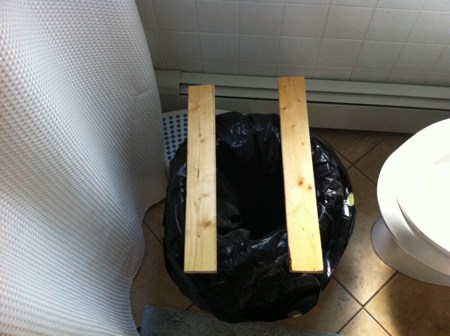
If you feel like spending a little money you can pick up a toilet seat cover made for a 5-gallon bucket.
I’ve also seen them sell bags that are made for these 5-gallon expedient toilets as well as toilet deodorants
that control the smell and are made for these types of portable toilets. I don’t have any experience with these but they seem to get good reviews in Amazon (click on an image to see the product and reviews):
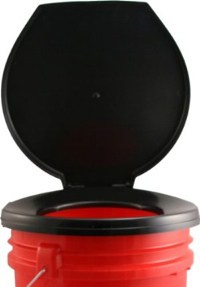 |
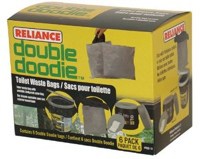 |
 |
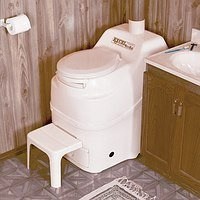 For those of you with a bit more money in your pockets, they sell non-electric composting toilets
For those of you with a bit more money in your pockets, they sell non-electric composting toilets that are completely off-grid, require no water, and supposedly convert human waste into usable compost without odor.
If any of you have these types of toilets, I’d love to hear from your experiences. That may be something that an apartment/city dweller could use in a SHTF situation.
Conclusion
I hope you come out of this post realizing how important the safe disposal of human waste is and how you can properly take care of you and your families waste if times get bad.
In the next and final article in this series I’ll be covering how you can properly dispose of garbage in a grid-down scenario.


